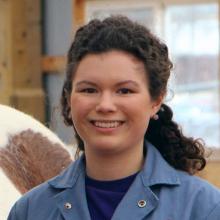My time is Eastern Ontario has come to a close. I’ve just finished another two weeks riding with the large animal vets and will be travelling to Ravena, New York to The Equine Clinic at OakenCroft for two weeks of solely equine practice. While I have been able to see some equine appointments, the majority of the calls that Vankleek Hill Veterinary Services receives have to do with cows. While most of the calls are for routine pregnancy checks or farm visits another common call is for a cow ‘off feed’ or with a ‘twist’.
Cows are frequently referred to as having ‘4 stomachs’ but in truth they only have one true stomach, the abomasum, which acts very similar to dog, cat and human stomachs in that it produces acid which aids in the breakdown of foodstuffs. The abomasum is normally found ventrally (near the bottom of the cow) and slightly to the right. When a cow gives birth to a calf, eats less feed (for a multitude of reasons), has decreased intestinal motility or has a change in physiologic demand there tends to be more empty space in the abdomen. With all this empty space the abomasum begins to move around. It is possible for the abomasum to move to either the left side of the cow or higher up the right. When it moves around there is a possibility that it may become torsed and/or fill with air and become stuck out of place. The cow then generally goes ‘off feed’, produces less milk and less manure.
To diagnose a displaced abomasum the veterinarian will use their stethoscope to percuss both the left and right abdominal walls listening for the sound of a ‘ping’ that is representative of air trapped within the abomasum. An incision is then made in either the right paralumbar fossa (underneath the cows lumbar vertebrae) or right paramedian (just off center from the ventral midline) once the specific area has been blocked using local anesthetic. From there the veterinarian will deflate and reposition the stomach, adhere it to the body wall and close the incision. The cow is normally then given fluids and placed on a course of antibiotics (even though the veterinarian makes every effort to be sterile the barn itself is not exactly a pristine environment).
I’ve been fortunate to see both left and right displaced abomasums. I’ve also been able to put on a sterile palpation sleeve, reach inside the cow and palpate the firm enlarged stomach. Having the opportunity to reach inside the cow and correlate what I hear with percussion with what is going on inside has really helped solidify my book learning.
I’d like to thank the staff and clients at both Hawkesbury Animal Hospital and Vankleek Hill Veterinary Services for all the mentoring, learning experiences and building my confidence working with all species. I very much appreciate the support and will definitely remember these past eight weeks as my own personal James Herriot experience.
